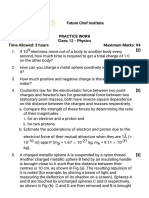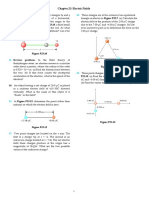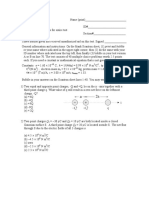Electrostatics Problems
Electrostatics Problems
Uploaded by
quasar2138Copyright:
Available Formats
Electrostatics Problems
Electrostatics Problems
Uploaded by
quasar2138Copyright
Available Formats
Share this document
Did you find this document useful?
Is this content inappropriate?
Copyright:
Available Formats
Electrostatics Problems
Electrostatics Problems
Uploaded by
quasar2138Copyright:
Available Formats
Electric flux, Gauss Law
1.An electric field given by E = 4.0i - 3.0(y2 + 2.0)j pierces a Gaussian cube of edge length 2.0 m and positioned as shown in adjacent figure.. (The magnitude E is in newtons per coulomb and the position x is in meters.) What is the electric flux through the (a) top face, (b) bottom face, (c) left face, and (d) back face? (e) What is the net electric flux through the cube? [Ans.(a) -72 Nm2/C(b) 24 Nm2/C (c) -16 Nm2/C (d) 0 (e) -48 Nm2/C] 2.A point charge causes an electric flux of -103 Nm2/C to pass through a spherical Gaussian surface of radius 10 cm centred on charge. (a) If the radius of the Gaussian surface were doubled, how much flux would pass through the surface? (b) What is the value of point charge?
3. In adjacent figure , a proton is a distance d/2 directly above the center of a square of side d. What is the magnitude of the electric flux through the square? [Ans.3.01 10-9 Nm2/C]
4.At each point on the surface of a cube electric field is parallel to z-axis. The length of the cube is 3.0 m. On the top face of the cube field is E = -34k N/C, and on the bottom face it is E = 20k N/C. Determine the net charge contained within the cube. [Ans. 4.3 10-9 C]
5. Adjacent Figure shows a closed Gaussian surface in the shape of a cube of edge length 2.00 m. It lies in a region where the non uniform electric field is given by E = (3.00x + 4.00)i + 6.00j + 7.00k N/C, with x in meters. What is the net charge contained by the cube? [Ans. 2.1310-10N/C]
6.A particle of charge +q is placed at one corner of a Gaussian cube. What multiple of q/0 gives the flux through (a) each cube face forming that corner and (b) each of the other cube faces? [Ans. (a) 0 (b) q/240] 7. An isolated conductor has net charge +1010 -6 C and a cavity with a point charge q = +3.010-6 C. What is the charge on (a) the cavity wall and (b) the outer surface? [Ans.(a) -3.010-6 C (b) 1.3 10-5 C] 8. A long, non conducting, solid cylinder of radius 4.0 cm has a non uniform volume charge density p that is a function of radial distance r from the cylinder axis: p = Ar2. For A = 2.5 C/m5, what is the magnitude of the electric field at (a) r = 3.0 cm and (b) r = 5.0 cm? [Ans.(a) 1.9N/C (b) 3.6N/C] 9.An electron is shot directly toward the centre of a large metal plate that has surface charge density -2.0 10-6 C/m2. If the initial kinetic energy of the electron is 1.60 10-17 J and if the electron is to stop (due to electrostatic repulsion from the plate) just as it reaches the plate, how far from the plate must the launch point be? [Ans. 4.410-4 m]
10. Two charged concentric spherical shells have radii 10.0 cm and 15.0 cm. The charge on the inner shell is 4.0010 -8 C, and that on the outer shell is 2.0010 -8 C. Find the electric field (a) at r = 12.0 cm and (b) at r = 20.0 cm. [Ans.(a) 2.5104N/C (b) 1.35104 N/C] 11.The volume charge density of a solid non conducting sphere of radius R = 5.60 cm varies with radial distance r as given by = 14.1r/R(in pC/m3). (a) What is the sphere's total charge? What is the field magnitude E at (b) r = 0, (c) r = R/2.00, and (d) r = R? (e) Graph E versus r. [Ans.(a) 7.78 10-15 C (b) 0 (c) 5.5810-3 N/C (d) 2.2310-2 N/C] 12. The electric field in a particular space is E = (x + 2)i N/C, with x in meters. Consider a cylindrical Gaussian surface of radius 20 cm that is coaxial with the x axis. One end of the cylinder is at x = 0. (a) What is the magnitude of the electric flux through the other end of the cylinder at x = 2.0 m? (b) What net charge is enclosed within the cylinder? [Ans.(a) 0.50 Nm2/C (b) 2.2 10-12 C] 13. Charge Q is uniformly distributed in a sphere of radius R. (a) What fraction of the charge is contained within the radius r = R/2.00? (b) What is the ratio of the electric field magnitude at r = R/2.00 to that on the surface of the sphere? [Ans.(a) 1/8 (b) 1/2] 14. Charge of uniform surface density 8.00 nC/m2 is distributed over an entire xy plane; charge of uniform surface density 3.00 nC/m2 is distributed over the parallel plane defined by z = 2.00 m. Determine the magnitude of the electric field at any point having a z coordinate of (a) 1.00 m and (b) 3.00 m. [Ans.(a) 2.82102 N/C (b) 6.21102 N/C]
You might also like
- Chapter 22 Gauss's Law: University Physics, 13e (Young/Freedman)Document17 pagesChapter 22 Gauss's Law: University Physics, 13e (Young/Freedman)Rachelle SaavedraNo ratings yet
- 1402 Exam 1 ReviewDocument16 pages1402 Exam 1 ReviewMartin SeungWhan KimNo ratings yet
- Ncert NumericalsDocument3 pagesNcert NumericalsAshok PradhanNo ratings yet
- Phy SolnDocument4 pagesPhy Solnenhanced081No ratings yet
- Two Small Spheres in MotionDocument12 pagesTwo Small Spheres in MotionharshanauocNo ratings yet
- Worksheet 2 Electric Charges and Field (Numerical and Conceptual)Document6 pagesWorksheet 2 Electric Charges and Field (Numerical and Conceptual)jeeaspirant2025sNo ratings yet
- Assignment Electrostatcs XIIDocument6 pagesAssignment Electrostatcs XIItanishrbNo ratings yet
- Practice Questions Chs 21-24 1Document40 pagesPractice Questions Chs 21-24 1jevanjunior0% (1)
- Ch-1 PhysicsDocument16 pagesCh-1 Physicstitanium.96450No ratings yet
- Electromagnetic Wave ExerciseDocument10 pagesElectromagnetic Wave ExerciseAnkit VatsaNo ratings yet
- Print Question PaperDocument8 pagesPrint Question PaperSaniya MemonNo ratings yet
- NDocument4 pagesNBHAAJI0001No ratings yet
- Chapter 5 - Electric FieldDocument5 pagesChapter 5 - Electric FieldTHIÊN LÊ TRẦN THUẬNNo ratings yet
- DR - Hannan Saadeh Solved Problems PDFDocument50 pagesDR - Hannan Saadeh Solved Problems PDFAbdNo ratings yet
- Chapter 1 - Assignment 3Document2 pagesChapter 1 - Assignment 3paperNo ratings yet
- Review Test 1314Document11 pagesReview Test 1314Hassan AliNo ratings yet
- Cheat Sheet-Physics 2Document1 pageCheat Sheet-Physics 2AnanyaBandyopadhyayNo ratings yet
- Electric Charges and FieldsDocument4 pagesElectric Charges and Fieldsdasnishith70No ratings yet
- p240w12 Mid1-2Document14 pagesp240w12 Mid1-2shlaeaNo ratings yet
- Coulombs Law2Document2 pagesCoulombs Law2Daniel BautistaNo ratings yet
- Electrostaitics Class 12thDocument3 pagesElectrostaitics Class 12thvishnuyterNo ratings yet
- Previous Exams Questions Ch23-24-With NotesDocument11 pagesPrevious Exams Questions Ch23-24-With NotesaamerbolookiNo ratings yet
- Prac FinaleDocument14 pagesPrac FinaleadadafasfasNo ratings yet
- QB 2 For 12STDDocument42 pagesQB 2 For 12STDkhatwaniv07No ratings yet
- Practice Problem - Electric Field - PHY-2105Document3 pagesPractice Problem - Electric Field - PHY-2105mmiti2330122No ratings yet
- Phys2 Midterm Exam F2019 20 With NotesDocument12 pagesPhys2 Midterm Exam F2019 20 With NotesaamerbolookiNo ratings yet
- Classroom Assignment 3 With AnswersDocument3 pagesClassroom Assignment 3 With AnswersBishoy EmileNo ratings yet
- PHYF125 Tutorial Questions Tri 2 201617Document11 pagesPHYF125 Tutorial Questions Tri 2 201617Sufian PianNo ratings yet
- Physics 220 Homework: Spring 2008Document27 pagesPhysics 220 Homework: Spring 2008Jeff Pratt100% (1)
- In Your Name Where Indicated in The Upper Right Corner Then (2) Do The Same With YourDocument12 pagesIn Your Name Where Indicated in The Upper Right Corner Then (2) Do The Same With YouradadafasfasNo ratings yet
- Class 12 CH 1 Textual Exercise AnswersheetDocument19 pagesClass 12 CH 1 Textual Exercise Answersheettechbyteofficial03No ratings yet
- ELECTRIC CHARGES AND FIELDS (Pyq)Document5 pagesELECTRIC CHARGES AND FIELDS (Pyq)Abhishek Chaudhary100% (1)
- Electric Charges and FieldsDocument31 pagesElectric Charges and Fieldsv31798097No ratings yet
- HomeworkDocument13 pagesHomeworkElen MariNo ratings yet
- E1a 121 s06txtDocument4 pagesE1a 121 s06txtBob TheBuilderNo ratings yet
- AP - IB Review Guide CH15Document5 pagesAP - IB Review Guide CH15Muhammad SyarifudinNo ratings yet
- Final 2018Document3 pagesFinal 2018Ashraf WaleedNo ratings yet
- Phy MCQ ADNDocument9 pagesPhy MCQ ADNudayavidya41No ratings yet
- Class XII - NEET PhysicsDocument16 pagesClass XII - NEET PhysicsVaishali SoniNo ratings yet
- PhysicsDocument17 pagesPhysicspaninikumar0000No ratings yet
- Ch. 1 Electric Charges and Fields NCERT & PYQsDocument96 pagesCh. 1 Electric Charges and Fields NCERT & PYQsLakshya Jain100% (1)
- Worksheet PotentialDocument3 pagesWorksheet PotentialRuchi ChinfhaChinthaNo ratings yet
- Class 12 Physics WorksheetDocument2 pagesClass 12 Physics Worksheetyashverma2786No ratings yet
- Tutorial ProblemsDocument2 pagesTutorial Problemsdeviselva75No ratings yet
- Class Xii CH-1 Electric Charges & FieldsDocument4 pagesClass Xii CH-1 Electric Charges & Fieldssnehachoudhary9968No ratings yet
- CH 1 Electric Charges and FieldsDocument5 pagesCH 1 Electric Charges and Fieldskrekhanandu24No ratings yet
- 12 Physics 1Document2 pages12 Physics 1Aman ShuklaNo ratings yet
- Physics 1653 Exam 3 - Review Questions: Sphere A Sphere BDocument39 pagesPhysics 1653 Exam 3 - Review Questions: Sphere A Sphere BPi PoliNo ratings yet
- W2016 PHYS259 Final Booklet I AnswersDocument12 pagesW2016 PHYS259 Final Booklet I AnswersYasmeenNo ratings yet
- Physics Practice With AnswersDocument7 pagesPhysics Practice With Answersmuhammad waqasNo ratings yet
- XII-SCIENCE-24-25-SUMMER HOLIDAY ASSIGNMENT - RemovedDocument14 pagesXII-SCIENCE-24-25-SUMMER HOLIDAY ASSIGNMENT - RemovedSuvasish NathNo ratings yet
- Forum Diskusi 1-2 Electric Charge and Electric Field)Document7 pagesForum Diskusi 1-2 Electric Charge and Electric Field)heroNo ratings yet
- بيوفيزكس هاله شيت 2Document2 pagesبيوفيزكس هاله شيت 2nagyrashad123No ratings yet
- Print PaperDocument27 pagesPrint PaperjayanthisureshkumarcNo ratings yet
- Auk Phy116 Alzu3bi CH21 Part2 by BaderDocument33 pagesAuk Phy116 Alzu3bi CH21 Part2 by Badersaiedali2005No ratings yet
- Chap23 10Document10 pagesChap23 10litrakhanNo ratings yet
- Electric FieldDocument2 pagesElectric FieldAndres ZerrathoNo ratings yet
- Electron Beam-Specimen Interactions and Simulation Methods in MicroscopyFrom EverandElectron Beam-Specimen Interactions and Simulation Methods in MicroscopyNo ratings yet
- MCQ DC Machines MasterDocument16 pagesMCQ DC Machines MasterDeepak Choudhary DCNo ratings yet
- PhotoconductivityDocument33 pagesPhotoconductivitySarathy Kannan42% (12)
- SudheerDocument17 pagesSudheerkrishcvrNo ratings yet
- How To Make A Softstarter PDFDocument6 pagesHow To Make A Softstarter PDFLeonNo ratings yet
- EGF316 Rotating Discs - Notes PDFDocument11 pagesEGF316 Rotating Discs - Notes PDFTriranga BikromNo ratings yet
- Poka Yoke With SenzorsDocument5 pagesPoka Yoke With SenzorsGeorge SubaNo ratings yet
- What Is EarthingDocument4 pagesWhat Is EarthingmshahidshaukatNo ratings yet
- Photoelectric Sensors W100, Photoelectric Retro-Reflective Sensor, Standard OpticsDocument7 pagesPhotoelectric Sensors W100, Photoelectric Retro-Reflective Sensor, Standard Opticsmas madNo ratings yet
- Applied Physics Polytechnic 2nd Sem Question PeparDocument2 pagesApplied Physics Polytechnic 2nd Sem Question PeparROBOTICS TECHNOLOGYNo ratings yet
- IFC Q & A 2 - ElectronicsDocument6 pagesIFC Q & A 2 - ElectronicsJohn Paul M. TubigNo ratings yet
- Chapter 1Document11 pagesChapter 1John Andrew AndresNo ratings yet
- A. Basics of Electrical Engineering: EE101 SyllabusDocument2 pagesA. Basics of Electrical Engineering: EE101 SyllabusritwikNo ratings yet
- Gravity Probe B: Final Results of A Space Experiment To Test General RelativityDocument5 pagesGravity Probe B: Final Results of A Space Experiment To Test General RelativitygiancarlostabileNo ratings yet
- Function 5 ELECTRICAL Quick Reference NotesDocument81 pagesFunction 5 ELECTRICAL Quick Reference NotesAshok Kumar0% (1)
- Assignment of EeeDocument4 pagesAssignment of EeeHarshilNo ratings yet
- Dynamic Testing of Combined Rock Bolt and Mesh SchemesDocument10 pagesDynamic Testing of Combined Rock Bolt and Mesh SchemesAlex RiveraNo ratings yet
- Ei 28Document1 pageEi 28bahmanNo ratings yet
- CHV 160 English Manual - V1.0Document106 pagesCHV 160 English Manual - V1.0Aung Naing OoNo ratings yet
- Testing Electronic ComponentsDocument10 pagesTesting Electronic ComponentsArdit MxxNo ratings yet
- N R RN N: AnswersDocument1 pageN R RN N: AnswersMeme PageNo ratings yet
- Studyastronomy Module Catalogue27mar2012 PDFDocument93 pagesStudyastronomy Module Catalogue27mar2012 PDFjoshuaNo ratings yet
- TutorialDocument57 pagesTutorialAbimael wendimuNo ratings yet
- Sample Midterm Physics 130Document9 pagesSample Midterm Physics 130Peter LiNo ratings yet
- Experiment 1 Lab ReportDocument10 pagesExperiment 1 Lab ReportLydia BummNo ratings yet
- AC Loss Characteristics and Permittivity (Dielectric Constant) of Solid Electrical InsulationDocument20 pagesAC Loss Characteristics and Permittivity (Dielectric Constant) of Solid Electrical InsulationAnbuchelvan C100% (1)
- Design of Class E Resonant Rectifiers and Diode Evaluation For VHF Power ConversionDocument14 pagesDesign of Class E Resonant Rectifiers and Diode Evaluation For VHF Power ConversionAdam RodriguezNo ratings yet
- Ec 2253 Electromagnetic Fields L T P C 3 1 0 4Document2 pagesEc 2253 Electromagnetic Fields L T P C 3 1 0 4Karthikeyan_Go_9525No ratings yet
- RRP AGRO TR Test Report 33 - 11 PDFDocument9 pagesRRP AGRO TR Test Report 33 - 11 PDFJRC TestingNo ratings yet
- CTERP2000 Application NotesDocument21 pagesCTERP2000 Application Noteshizbi7No ratings yet
- Linear Motion 2Document4 pagesLinear Motion 2Fata Maimunah50% (8)

























































































